617 Search Results for tell me about it
August 27, 2013
by Carole Zangari -
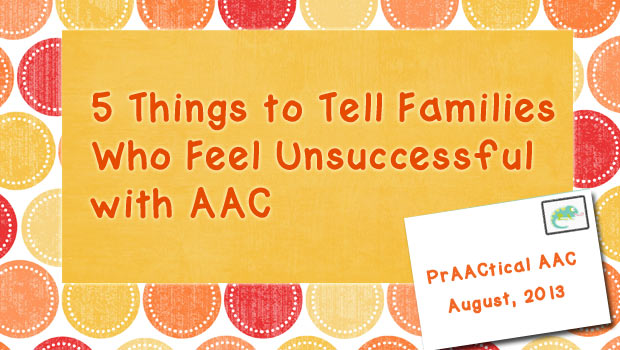
As readers of this blog know, we are sometimes awed and inspired by families of people with AAC needs. There are many who seem to know just what to do and make it a priority to implement AAC in their homes. It isn’t always smooth sailing, though, and we often rack our brains to find ways to support famiies who are struggling. Here are some prAACtical ideas of things to say when a family member is feeling unsuccessful. 1. “Take small bites: You don’t have to revolutionize your household to help your child/parent. Do what you can do, when you can do it. Small changes are more sustainable, anyway.” 2. “Starting over is better than giving up: Yes, you may have tried XYZ before but things are different now. Let’s give it another shot.” 3. “I won’t judge you. ” Say it and mean it. 4. “You’re not alone.”... [Read More...]
August 15, 2013
by Carole Zangari -
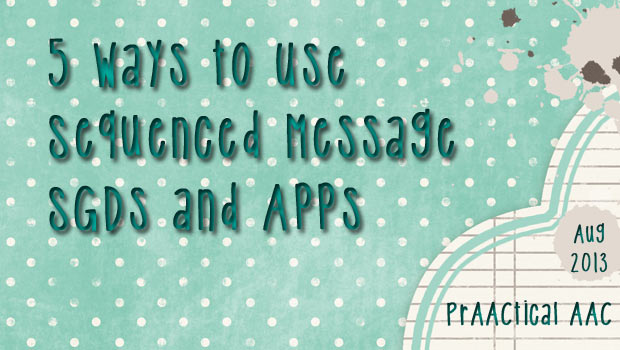
We’ve been having fun with sequenced message communicators and apps this summer. Yes, they’ve been around for a long time, but that doesn’t mean we use them to capacity. You just can’t beat those simple technologies for flexibility and ease of use. Here are some of the things we’ve been trying out. 1. Say hello: Record a variety of age appropriate greetings so that each time the AAC learner uses it, they greet their peers in different ways (e.g., Teen: “What’s up? Hey, how’s it going? Lookin’ good! Nice to see ya! Hey, what’s goin’ on?”). 2. Get the group’s attention: Allow AAC learners to help get their classmates’ attention (e.g., “Listen up, everyone! Mrs. Martinez has something to say”. “Hey, room 113-Mrs. M is ready for us to move on.” “Eyes forward, room 113.”). 3. Give instructions: Record steps to an activity so that the AAC learner can give... [Read More...]
July 20, 2013
by Robin Parker -
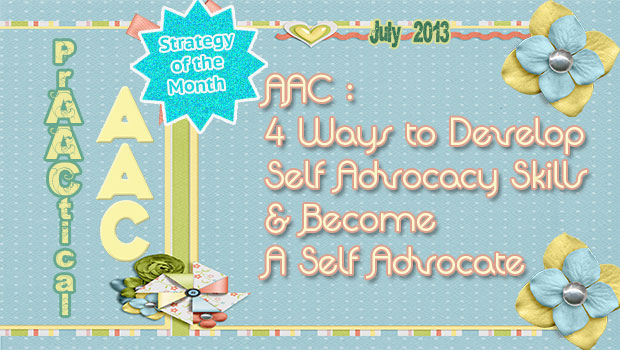
Self Advocacy comes in many shapes and forms for all learners. We all need to have a level of self advocacy skills to have a positive self-esteem, to continue a path of life long learning, and to defend and protect ourselves in situations that potentially can be harmful. The teaching of self advocacy begins with learning to request and protest but goes way beyond that for ALL learners. For those with AAC needs, specific strategies and direct instruction are often necessary to make self advocacy a comprehensive and robust skill. Self advocacy skills are a priority for older learners so for our Strategy of the Month, we will discuss some ways to help develop self advocacy skills beyond the requesting and protesting levels. We hope to build strong self advocacy skills for ALL learners. Rating Scales– Teach the use of rating scales to help AAC learners give their opinions on... [Read More...]
July 18, 2013
by Carole Zangari -
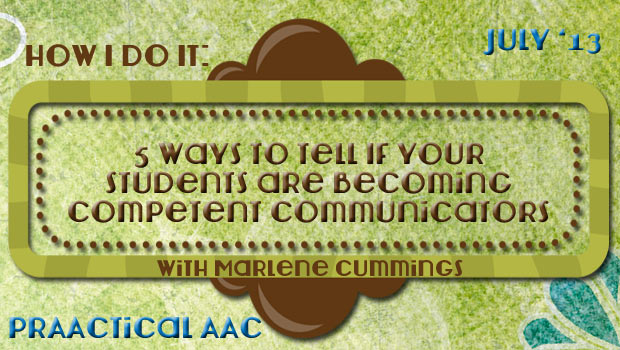
It’s always a good day when we get to share the thoughts of veteran AAC SLP, Marlene Cummings. In this post, Marlene talks about the signs to look for as clients gain skills with AAC and wraps up her series of posts on her yearlong experience in providing embedded professional learning experiences in Oakland Schools. You can see her earlier posts on cultivating the right mindset, their framework for AAC success, her AAC implementation toolbox, and the communication environment. 5 things in our “Destination Toolbox” “Are we there yet?” or “Five Ways to Tell That Your Students are Becoming Competent Communicators” Students are: Participating in the purposes of communication by novelly generating multiple word phrases demonstrating a variety of communicative functions Taking multiple communicative turns with multiple partners in multiple environments Using words from many different word classes Using words to talk about words Using language to communicate and communicating to learn... [Read More...]
July 16, 2013
by Robin Parker -
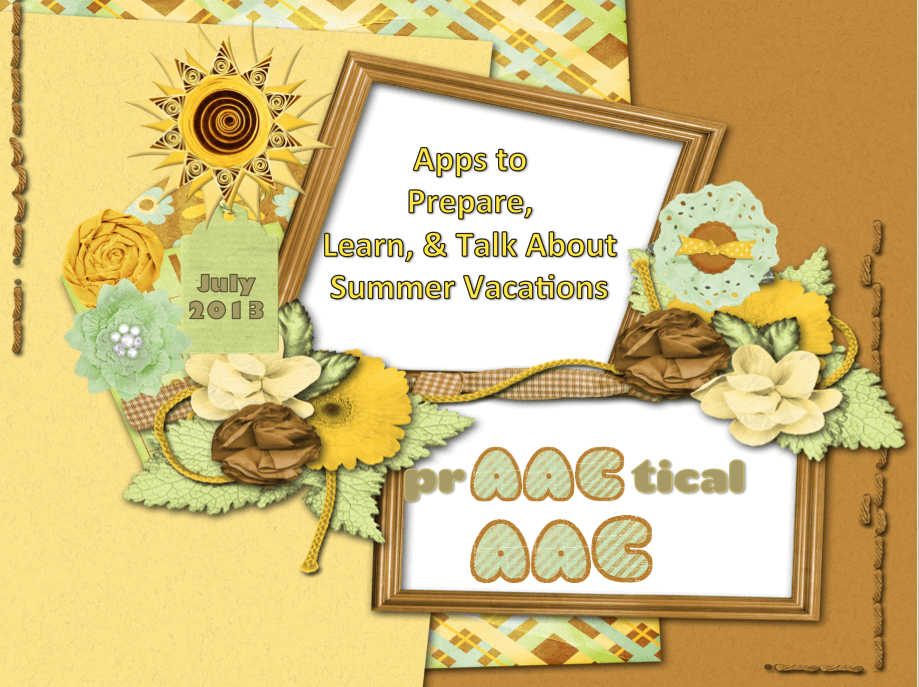
Vacations are great! But all great vacations need preparation because new experiences and change can be stressful even if the stress is good. Vacations are also opportunities for lots and lots of meaningful language experiences. Here are some apps specific to vacations but also don’t forget your schedule apps (e.g., Choiceworks, Kids Calendar, etc) or your story creations apps (e.g., Pictello, Story Creator, iCreate… Social Skills Stories, etc.) to customize for specific personal vacations. Prepare, Learn, & Talk About Summer Vacations My Little Suitcase by Moms with Apps Packing for Vacation- Prepare your suitcase for Traveling Bogga Vacation Planes by Byron Barton Miko Goes on Vacation: An interactive bedtime story book for kids about Miko’s first beach holiday, where he enjoys swimming and making new friends, by Brigitte Weninger illustrated by Stephanie Roehe. Roxie’s a MAZEING Vacation Adventure Lucy’s First Flight: A Geography Story Panda Book ... [Read More...]
June 28, 2013
by Carole Zangari -
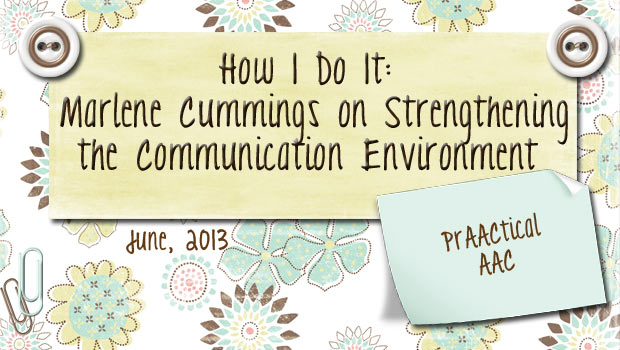
Marlene Cummings is back to share some thoughts on creating communication-friendly environments. As an AAC consultant to the Oakland Schools, Marlene gets to support AAC implementation in a variety of classrooms with all types of learners. You can read her earlier posts here and here. ::::::::::::::::::::::::::::::::::::::::::::::::::::::::::::::::::::::::::::::::::::::::::::::::::::::::::::::::::::::::::::::::::::::::::::::::::::::::: 5 Things to Consider in the “Communication Environment” The first thing we want to ask: Is language being represented visibly? We in AAC are often known by our “stuff”. Because we need to represent language visibly and love technology, we typically have a lot of “stuff”. I, for one, currently have a large storage unit holding 30+ years of “stuff” waiting to be distributed to all my new teams since I am no longer in the classroom. Let’s start by looking around our instructional environment. It is our intention to model the use of language being represented visibly and to provide the vocabulary and opportunities for... [Read More...]
June 15, 2013
by Carole Zangari -
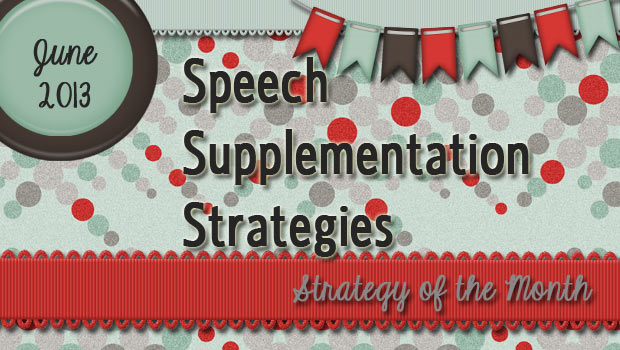
Anyone who has had a conversation with someone affected by aphasia is probably familiar with the ‘20 Questions’ approach to resolving communication breakdowns. Asking questions helps us take the piece of the message we understand (or think we do!) and build on that to gain more insight into the communicator’s intent. Take this exchange between a woman, Sandy, and her mother-in-law, Joan. Joan had a stroke a few years back and has both aphasia and dysarthria. Joan: “Gay” Sandy: “Gay? What do you mean, mom? Someone’s gay?” Joan: Shake head. “Gay” Sandy: “I’m not sure, mom. Gay?” Joan: “Gay” Points to the front door Sandy: “Kay? Are you telling me about Kay from across the street?” Joan: “Gay.” Nods Sandy: “What about Kay? Did she call?” Joan: Shakes head no Sandy: “Do I need to call her?” Joan: Shakes head no Sandy: “Did she stop by?” Joan: “Aaadihdih” Sandy: “Did... [Read More...]
June 1, 2013
by Carole Zangari -
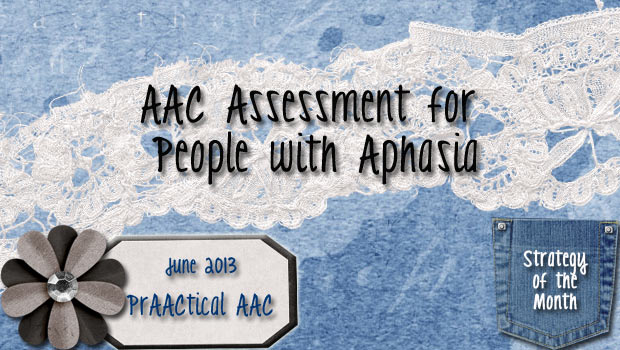
Many people with aphasia fail to regain sufficient speech and language skills to meet their communication needs. With more than one million people with aphasia in the US alone, chances are most people reading this know at least one person affected by the disorder. While many go on to regain functional speech and language skills, some remain unable to communicate well enough catch up with a neighbor, talk about bills with a spouse, ask a question in a store, play with a grandchild, or tell their healthcare providers about side effects or symptoms. It’s hard to really imagine how devastating and isolating this experience may be. Aphasia Awareness Month seemed like the perfect time to reach out to SLPs with information on AAC for people with aphasia. In this post, we’ll share some thoughts and resources on assessment. Assessment activities are, of course, driven by the purpose for which the... [Read More...]
May 23, 2013
by Carole Zangari -
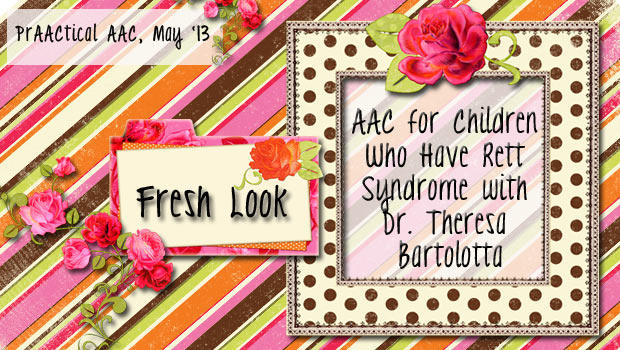
In our SLP training programs, few of us learned about Rett Syndrome or how to provide services to children with that disorder. We’re so pleased to have a guest post on AAC services for children with Rett by Dr. Theresa Bartolotta, Director of Assessment in the Office of the Provost, and Associate Professor in the Department of Speech-Language Pathology, at Seton Hall University, in South Orange, New Jersey. An SLP with over 30 years of clinical experience, she specializes in communication disorders in children with significant disabilities with a special interest in autism and Rett syndrome. Our field is still learning about Rett syndrome and we are still discovering new things about the range of skills and abilities present in the children who have it. In this post, Dr. Bartolotta gives us some background about the syndrome and discusses implications for treatment. I am thrilled to have this opportunity to post... [Read More...]
May 16, 2013
by Robin Parker -
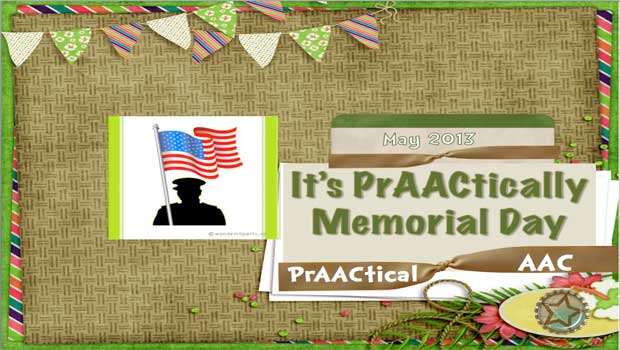
It’s PrAACtically Memorial Day! Memorial Day is prAACtically here. We remember, appreciate, and honor the people who have protected our freedoms. Getting ready so EVERYONE can participate is important. We wrote about memorial day last year and had found some good gluten-casein free Memorial Day recipes. There are even more resources today. Check out Gluten Free Memorial Day Weekend Menu and Recipe Ideas or Gluten Free Casein Free Applesauce Muffins. Cooking and baking provide meaningful language experiences as well as just plain fun. There are symbol based recipes on Pinterest at Picture Recipes and Visual Recipes for Children with Autism, and at Specialty Chef. There are also prAACtical AAC ways to teach about Memorial Day’s meaning as well as the typical memorial day vacations, activities, and events. Learning about Memorial Day Memorial Day Activity Board Memorial Day Vocabulary Cards Memorial Day Bingo Memorial Day Adapted Bingo Summer Pack Memorial Day After learning about Memorial... [Read More...]









